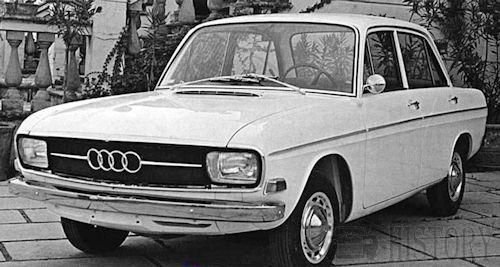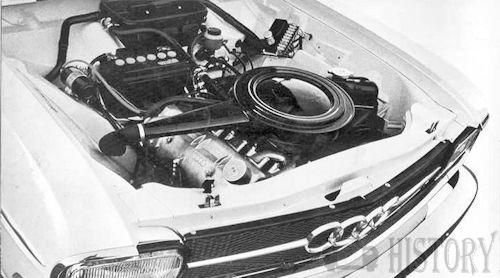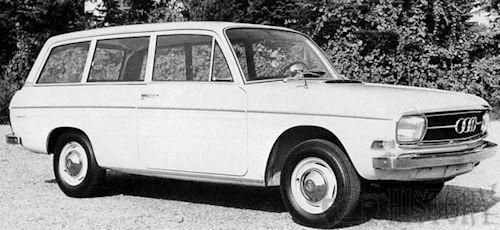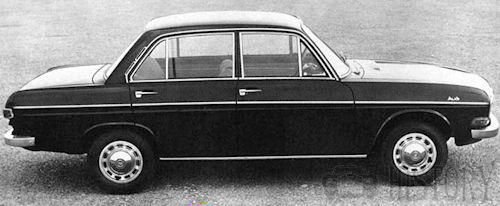Audi F103 (60/72/75/80/90)
 |
|
| Manufacturer | Auto-Union |
|---|---|
| Production | September 1965 to July 1972 |
| Built | 416,853 built: Sedan/Saloon: 386,361 Variant (station wagon/estate): 27,492 |
| Assembly | Ingolstadt, Germany |
| Predecessor | DKW F102 |
| Successor | Audi 80 |
| Class | Compact executive car |
| Body style | 2- or 4-door saloon 3-door estate |
| Layout | Longitudinal front engine, front-wheel drive |
| Engine | 1.5–1.8 L inline-4 |
| Transmission | 4-speed manual |
| Wheelbase | 2,490 mm (98 in) |
| Length | 4,380 mm (172 in) |
| Width | 1,626 mm (64.0 in) |
| Curb weight | 960 kg (2,100 lb)−1,065 kg (2,350 lb) |
F103 is the internal designation for a series of car models produced by Auto Union in West Germany from 1965 to 1972, derived from the earlier DKW F102. To signify the change from a two-stroke to four-stroke engine, the DKW marque was dropped in favour of Audi, a name dormant since before the Second World War.
Models
The first model was launched simply as the Audi, later being renamed the Audi 72 (72 being the nominal power output of the engine).The more powerful Audi 80 and Audi Super 90 sports saloons appeared in 1966: in 1968 the arrival of the less powerful Audi 60 completed the range.The Audi 75 replaced both the Audi 72 and the Audi 80 from 1969 onwards.Bringing back the name of the well-known pre-war model, the Auto-Union as part of its re-development drive, is experimenting with the solution of the four-stroke engine, abandoning the two-stroke type it has always adopted until now.
In 1972 the F103 series was discontinued in favour of the "B1" Audi 80.
Engines

The F103 series were equipped exclusively with four-cylinder four-stroke engines. These were longitudinally mounted. This combination of front-wheel drive, which Auto Union's DKW brand had pioneered during the 1930s, and the longitudinal positioning of a four-cylinder engine would provide the basic template for Volkswagen's successful new Passat as well as the Audi models Audi 80 and Audi 100 after Volkswagen acquired the business from Daimler-Benz late in 1964. Since the chassis on the F103 was taken from the DKW F102 with a 3-cylinder two-stroke engine, the longer engine meant that the cooling system had to be offset to the left of the engine instead of the normal position in front of it.
The engines of the F103 series were a joint development with Daimler-Benz who owned Auto-Union at the time (from 1958 to 1964). They were dubbed (medium pressure engines), because of their unusually high compression ratio, mid-way between conventional petrol and diesel engines.The new engine is extremely interesting. The 11:2 compression ratio is the highest in use among mass-produced cars and has made it easy to achieve a notable reduction in specific fuel consumption. With an engine capacity of 1,696 cu cm and the four cylinders inclined at 40° on the right it develops 80 hp DIN at 5,000 rpm.
PERFORMANCE: 60 1500cc
- Engine capacity: 91.29 cu in, 1,496 cu cm
- Fuel consumption: 32.4 m/imp gal, 27 mlUS gal, 8.7 1 x 100 km
- Max speed: 85.8 mph, 138 km/h
- max power (SAE): 66 hp at 4,750 rpm
- max torque (SAE): 87 1b ft, 12 kg m at 2,600 rpm
- max engine rpm: 5,500
- specific power: 44.1 hp/l
- power-weight ratio: 32.4 lb/hp, 14.7 kg/hp
- acceleration: 0—50 mph (0—80 km/h) 11.2 sec
Particular care has been taken in the study of turbulence phenomena both in the inlet and in the outlet stages. The shape of the inlet pipes has in fact been designed so as to lead to the formation of a current of gas rotating in the combustion chambers which lie along the same axis as the cylinder. The head is quite flat and the combustion chamber has been
hollowed out at the top of the piston. In spite of the high compression ratio, the engine is remarkably flexible with a maximum torque of 98 1b ft (13.5 kg m) at 3,000 rpm. The fuel consumption is exceptionally low for a 1,700 cc engined car.
PERFORMANCE: 80 1,696 cc
- Engine capacity: 103.49 cu In, 1,696 cu cm
- Fuel consumption: 33.6 m/imp gal, 28 m/US gal, 8.4 1 x 100 km
- Max speed: 91.9 mph, 148 km/h
- max power (SAE): 81 hp at 5,000 rpm
- max torque (SAE): 98-101 1b ft. 13.5-14 kg m at 2,000-3,500 rpm
- max engine rpm: 5,300
- specific power: 47.8 hp/l
- power-weight ratio: 27 lb/hp, 12.1 kg/hp
- acceleration: 0—50 mph (0—80 km/h) 9.2 sec
- speed in top at 1,000 rpm: 18 mph, 29 km/h.
Running gear
The car came with a four-speed manual transmission.Inboard mounted front disc brakes were featured, which was still unusual in the mid-size car market at this time. The rear brakes followed the more conventional drum configuration.
The transmission, as might be expected in an Auto Union, is front-wheel and this makes for pleasant and precise driving, qualities that become more and more accentuated as speed rises. Handling is what is to be expected of a front-wheel drive car, with all its well-known qualities and rare faults. The car reacts truly and its reliability is in no way diminished even when in the hands of a mediocre driver. These qualities are combined with steering a little too low geared for fast driving, although it is pleasing. It is clear that the makers have in this case given priority to the performance of the car in the town. The four-speed fully synchronized gearbox with an "overdrive" top has a steering column gear lever. The ratios have been carefully studied and they are of great assistance, allowing speeds of 47.2 mph (76 km/h) in second and 69.6 mph (112 km/h) in third, on trying roads.
PERFORMANCE: 90 1760cc
- Engine capacity: 107.39 cu in, 1,760 cu cm
- Fuel consumption: 31.7 m/imp gal, 26.4 m/US gal, 8.9 1 x 100 km
- Max speed: 101.3 mph, 163 km/h
- max power (SAE): 102 hp at 5,200 rpm
- max torque (DIN): 109 1b ft, 15 kg m at 3,000 rpm
- max engine rpm: 5,800
- specific power: 58 hp/l
- power-weight ratio: 21 lb/hp, 9.6 kg/hp;
- acceleration: 0—50 mph (0—80 km/h) 8.5 sec.
Bodywork
The F103 bodyshell was a development of the earlier DKW F102. The engine compartment had to be extended so that the new four-cylinder engine could be accommodated. The front and tail were also cosmetically revised: Audi F103s sold in Europe all featured quasi-rectangular headlamps which were becoming fashionable at the time, whereas the F102 had used round headlamp units.
The upholstery is quiet, pleasant and in excellent taste. The dominating features on the facia are two circular instruments that incorporate a clock. a water temperature gauge, and a petrol gauge that are very easy to read. Vision from the driver's seat is good and is assisted, in the case of rain. by two-speed windscreen wipers. The roomy boot has two useful side pockets in whicn small objects can be stowed away, prevented them from sliding around and rattling on corners
or uneven surfaces.
All Audi F103 models were offered as sedans with two and four doors. However, the two-door saloon/sedan was not sold in markets with little demand for two-door cars of this size, such as Italy and Britain.
With the exception of the Audi Super 90, the F103 series were available also as three-door station wagon models. Making its debut at the Geneva Motor Show in March 1966, this was called, like the Volkswagen estate/station wagon models, Variant.

Evolution
Initial changes were concentrated under the hood/bonnet where during the first two years of production the specification for the Solex carburetor was changed twice and in September 1967 the very high compression ratio was reduced from a (then) eye watering 1:11.2 to 1:9.1 which addressed serious "teething problems" with the engine as originally launched.
In September 1967 servo-assistance for the brakes became an option, the brakes on all but the basic model now being controlled using twin braking circuits, and by (in Germany) the final months of 1968 the range had settled down to three models, with the entry level Audi 60 powered by a 55 PS motor, the less basic Audi 75 producing 75 PS and the Audi Super 90 with 90 PS, able to challenge the performance image of some of the smaller BMWs.
Visually the car changed very little, but keen eyed observers would have noticed a discretely modernised rear from August 1970, with slightly larger rear lights and a reshaped bumper. The fuel filler moved from its location to the right of the license plate on the rear panel to a position on the right hand wing of the car, and following a general trend of the period was now shielded by a flap that was flush with the bodywork. Inside the 1970 upgrade also involved a reconfigured dashboard.

Commercial
During the early 1960s, Auto Union was in commercial retreat: the Audi F103 was a relative success when compared with recent Auto Union products, even if its commercial success was trumped by subsequent Audi models. In July 1967, it was reported that 100,000 Audis had been completed:production of the F103 had by now built up to a rate of almost 40,000 per year and the company was moved to deny speculation that another new Audi model would be presented at the Frankfurt Motor Show in the Autumn / Fall of 1967. (The Audi 100 was introduced only towards the end of 1968.)
Technical
-
Audi F103 72 75 80 Technical details and specifications (1965-1972)
ENGINE: 60 1500cc
4 stroke; cylinders: 4, in line
bore and stroke: 3.15 x 2.93 in, 80 x 74.4 mm
engine capacity: 91.29 cu in, 1,496 cu cm
compression ratio: 9.1
cylinder block: cast iron
cylinder head: light alloy
crankshaft bearings: 5
valves: 2 per cylinder, overhead, push-rods and rockers
camshafts: 1, side
lubrication: gear pump, full flow filter
carburation: 1 Solex 35 PDSIT-5 downdraught carburettor
fuel feed: mechanical pump
cooling system: waterENGINE: 80 1700cc
location front,4 stroke
cylinders: 4, slanted at 40° on right,in line
bore and stroke: 3.15 x 3.32 in, 80 x 84.4 mm
engine capacity: 103.49 cu in, 1,696 cu cm
compression ratio: 11.2
cylinder block: cast iron
cylinder head: light alloy
crankshaft bearings: 5
valves: 2 per cylinder, overhead, push-rods and rockers
camshafts: 1, side; lubrication: gear pump, full now filter
carburation: 1 Solex 38 PDSI downdraught carburettor
fuel feed: mechanical pump
cooling system: waterENGINE: 90 1,760 cu cm
4 stroke; cylinders: 4, slanted 40° to right, in line
bore and stroke: 3.21 x 3.32 in, 81.5 x 84.4 mm
engine capacity: 107.39 cu in, 1,760 cu cm
compression ratio: 10.6
cylinder block: cast iron
cylinder head: light alloy
crankshaft bearings: 5
valves: 2 per cylinder, overhead, push-rods and rockers
camshafts: 1, side
lubrication: gear pump, full flow filter
carburation: 1 Solex 32 DID TA downdraught carburettor
fuel feed: mechanical pump
cooling system: waterTRANSMISSION
driving wheels: front
clutch: single dry plate
gearbox: mechanical; gears: 4 + reverse
synchromesh gears: all
gearbox ratios: 1st 3.400, 2nd 1.940, 3rd 1.420, 4th 0.970, rev 3.100
gear lever location: steering column
final drive: spiral bevel
axle ratio: 3.888.CHASSIS
type integral
front suspension; independent, wishbones, lower leading arms,longitudinal torsion bars, anti-roll bar, telescopic dampers
rear suspension: rigid axle, swinging longitudinal trailing arms, transverse linkage bar, transverse torsion bars, telescopic dampers.STEERING
rack-and-pinion
turns of steering wheel lock to lock: 4.
turning circle (between walls): 36.1 ft, 11 mBRAKES
front disc (diameter 11.02 in, 280 mm), rear drum.ELECTRICAL EQUIPMENT
voltage: 12 V
battery: 55 Ah
generator type: dynamo, 490 W
ignition distributor: BoschDIMENSIONS AND WEIGHT
wheel base: 98.03 in, 2,490 mm
front track: 52.80 in, 1,341 mm
rear track: 52.20 in, 1,326 mm
overall length: 172.44 in, 4,380 mm
overall width: 64.02 in, 1,626 mm
overall height: 57.52 in, 1,461 mm
ground clearance: 6.30 in, 160 mm
dry weight: 2,161 1b, 980 kgModel Specifications 72/75/80/90
Audi F103
Audi 72
2- or 4-door saloon/sedan
3-door 'Variant' estate/station wagonAudi 75
2- or 4-door saloon/sedan
3-door 'Variant' estate/station wagonAudi 80
2- or 4-door saloon/sedan
3-door 'Variant' estate/station wagonAudi Super 90
2- or 4-door saloon/sedanYears Produced
1965–1969
1969–1972
1966–1969
1966–1972
Units Produced
122,579
49,794
Engine
M118 4-cylinder-inline engine (four-stroke), longitudinally front-mounted
Bore x Stroke
80 mm x 84.4 mm
81.5 mm x 84.4 mm
Displacement
1697 cc
1761 cc
Max. Power
72 PS (53 kW; 71 hp)
75 PS (55 kW; 74 hp)
80 PS (59 kW; 79 hp)
90 PS (66 kW; 89 hp)
at engine speed
5000 rpm
5000 rpm
5000 rpm
5200 rpm
Compression Ratio
11.2:1
9.1:1
11.0:1
10.6:1
Acceleration
0–100 km/h (0–62 mph)14.8 s
14.5 s
14.0 s
12.2 s
Max Speed
148 km/h (92 mph)
150 km/h (93 mph)
152 km/h (94 mph)
163 km/h (101 mph)
Fuel feed
single Solex carburetor
Valvetrain, cooling
OHV, water-cooled
Electrical system
12-volt
Front suspension
Double wishbone, torsion bar
Rear suspension
Beam axle, Trailing-arms, Panhard rod, Torsion bar
Brakes
Front inboard discs / Rear drum brakes
Body structure
Monocoque
Dry weight
960–1,065 kg (2,116–2,348 lb)
Track front/rear
1,343 mm (52.9 in) / 1,327 mm (52.2 in)
Wheelbase
2,490 mm (98 in)
Length x Width x Height
4,380 mm (172 in) x 1,626 mm (64.0 in) x 1,451 mm (57.1 in)
Steering, turning circle
rack & pinion, 10.59 m (34 ft 9 in)
© Motor car History
Service
-
Audi F103 72 75 80 Maintenance and Service Guide (1965-1972)
Gearbox and final drive oil: 3.52 imp pt, 4.23 LIS pt, 2 1, SAE 80, change every 18,600 miles, 30,000 km
greasing: none
normal tyre pressure: front 21 psi, 1.5 atm, rear 23 psi, 1.6 atm. 90 front 26 psi, 1.8 atm, rear 28 psi, 2 atm.
width of rims: 4.5"
tyres: 165 x 13
fuel tank capacity: 11.7 imp gal, 14 US gal
carrying capacity: 882 1b, 400 kg60 1500cc
fuel: 88 oct petrol
engine oil change: 7 imp pt. 8.5 US pt. 4 1, SAE 10W-30, change every 6,200 miles, 10,000 km
gearbox and final drive oil: 3.5 imp pt. 42 US pt. 2 1, SAE 80. change every 18,600 miles, 30,000 km tappet clearances: inlet 0.004 in, 0.10 mm, exhaust 0.010 in, 0.25 mm;
valve timing: inlet opens 6° before tdc and closes 38° after bdc, exhaust opens 41° before bdc and closes 5° after tdc80 1700cc
fuel: 98-100 oct petrol
engine oil change: 6.51 imp pt, 7.82 US pt, 3.7 1, change every 6,000 miles, 10,000 km
Total lubricating system capacity: 7.04 imp pt, 8.46 US pt
tappet clearances: inlet 0.002 in, 0.05 mm, exhaust 0.014 in, 0.35 mm
valve timing: inlet opens 6° before tdc and closes 38° after bdc, exhaust opens 41° before bdc and closes 5° after tdc
cooling system capacity: 13.20 imp pt, 15.86 US pt, 7.5 1.90 1760cc
fuel: 98-100 oct petrol
engine oil change: 7.04 imp pt, 8.46 US pt, 4 1, SAE 10W-30, change every 3,100 miles, 5,000 km
lubricating system capacity: 7.04 imp pt, 8.46 US pt, 4 1
cooling system capacity: 13.20 imp pt, 15.85 US pt
tappet clearances: inlet 0.006 in, 0.15 mm, exhaust 0.016 in, 0.40 mm
valve timing: inlet opens 6° before tdc and closes 38° after bdc,© Motor car History
